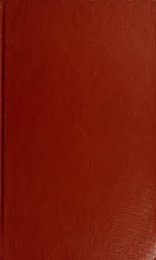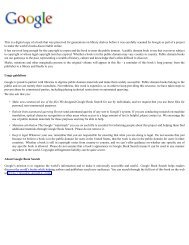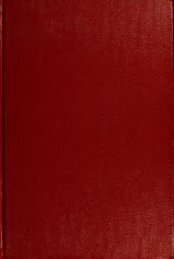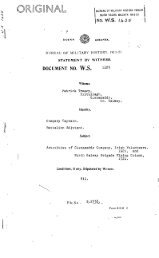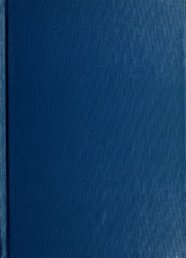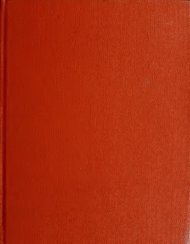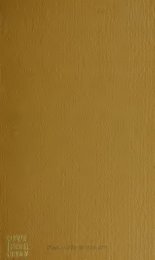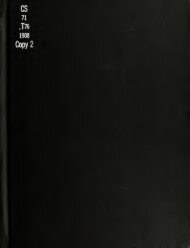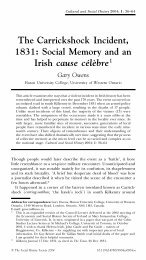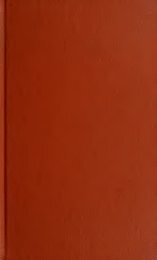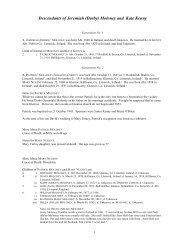Guide to the Tracy Family Papers - Tracey/Tracy/Treacy Family
Guide to the Tracy Family Papers - Tracey/Tracy/Treacy Family
Guide to the Tracy Family Papers - Tracey/Tracy/Treacy Family
You also want an ePaper? Increase the reach of your titles
YUMPU automatically turns print PDFs into web optimized ePapers that Google loves.
<strong>Tracy</strong> family papers<br />
MS 816 - Page 6<br />
The firm acquired a wide reputation by <strong>the</strong>ir work in designing important buildings in various parts of <strong>the</strong> country, and won<br />
a number of competitions, including <strong>the</strong> Ca<strong>the</strong>dral and <strong>the</strong> U.S. Post Office and Court House at Denver, Colo., <strong>the</strong> National<br />
Metropolitan Bank and <strong>the</strong> George Washing<strong>to</strong>n and Vic<strong>to</strong>ry Memorial in Washing<strong>to</strong>n, D.C. (<strong>the</strong> corner s<strong>to</strong>ne of <strong>the</strong> latter of<br />
<strong>the</strong>se buildings was laid in November 1921); <strong>the</strong> Connecticut Savings Bank in New Haven; and <strong>the</strong> Missouri State Capi<strong>to</strong>l.<br />
O<strong>the</strong>r buildings designed by <strong>the</strong> firm included <strong>the</strong> National Armory at Washing<strong>to</strong>n, D.C., not yet under construction, and <strong>the</strong><br />
original Yale Club in New York City. Mr. <strong>Tracy</strong> also made <strong>the</strong> plans for <strong>the</strong> remodelling of <strong>the</strong> sales offices of <strong>the</strong> Brick Row<br />
Print and Book Shop and <strong>the</strong> Yale University Press in New York City. In 1920 <strong>the</strong> firm of <strong>Tracy</strong> & Swartwout was awarded<br />
by <strong>the</strong> New York Chapter of <strong>the</strong> American Institute of Architects <strong>the</strong> Medal of Honor in recognition of <strong>the</strong>ir distinguished<br />
achievements in architecture, as exemplified in <strong>the</strong> Missouri State Capi<strong>to</strong>l and <strong>the</strong> U.S. Post Office and Court House at<br />
Denver.<br />
Evarts <strong>Tracy</strong> was one of <strong>the</strong> first men <strong>to</strong> offer his services <strong>to</strong> <strong>the</strong> government for <strong>the</strong> World War. He attended <strong>the</strong> Plattsburg<br />
Camp in 1917, where he commanded Company 15, and also underwent training at <strong>the</strong> American University in Washing<strong>to</strong>n.<br />
When plans were made for <strong>the</strong> organization of <strong>the</strong> Camouflage Section he was assigned <strong>to</strong> <strong>the</strong> staff of <strong>the</strong> Chief of Engineers<br />
for <strong>the</strong> purpose of recruiting, organizing, and equipping <strong>the</strong> section. At that time he held <strong>the</strong> rank of Captain in <strong>the</strong> Engineer<br />
Corps, but before going abroad in September 1917 he had received a commission as Major. After spending a brief period in<br />
England, he proceeded <strong>to</strong> France, where he commanded <strong>the</strong> 40th Engineers, a camouflage regiment, organized in France,<br />
largely from companies sent over from <strong>the</strong> United States. He was ordered <strong>to</strong> <strong>the</strong> British front and was at <strong>the</strong> first battle<br />
of Cambrai, where he received a slight wound. In January 1918 he was put in charge of camouflage training at <strong>the</strong> Army<br />
Engineer school at Langres. He was appointed Army Camouflage Officer in July 1918, having at one time over one hundred<br />
and fifty kilometres <strong>to</strong> look after, and by <strong>the</strong> following September was in charge of all camouflage sections, covering a large<br />
area of <strong>the</strong> western front. He was cited by General Pershing, and was recommended for <strong>the</strong> Distinguished Service Medal,<br />
which was awarded <strong>to</strong> him shortly before his death. In Oc<strong>to</strong>ber 1918 he returned <strong>to</strong> America <strong>to</strong> recruit and train two additional<br />
battalions of men for his sections, but <strong>the</strong> armistice rendered this unnecessary.<br />
He <strong>the</strong>n served on <strong>the</strong> staff of <strong>the</strong> Chief of Engineers in Washing<strong>to</strong>n for several months, and subsequently went <strong>to</strong> Panama<br />
<strong>to</strong> make a report on <strong>the</strong> defenses of <strong>the</strong> Canal Zone. He was relieved from active duty August 29, 1919, and resumed <strong>the</strong><br />
practice of his profession. In July 1921 he was at Camp Knox, where he gave instruction <strong>to</strong> various Field Artillery units. He<br />
<strong>the</strong>n went <strong>to</strong> France, and while <strong>the</strong>re unofficially represented <strong>the</strong> U.S. Army at French manoeuvres. Upon returning <strong>to</strong> <strong>the</strong><br />
United States in September, he was assigned <strong>to</strong> General Headquarters, with <strong>the</strong> rank of Lieutenant Colonel in <strong>the</strong> Engineer<br />
Reserve Corps. He had been in France since December 13, 1921, and for several months before his death he had been<br />
engaged in reconstruction work, making his headquarters in Paris. He was a member of <strong>the</strong> council of <strong>the</strong> National Sculpture<br />
Society and of <strong>the</strong> committee of experts of <strong>the</strong> Advisory Council of Real Estate Interests of New York. He also belonged <strong>to</strong><br />
<strong>the</strong> Beaux Arts Society of Architects, <strong>the</strong> American Institute of Architects, and <strong>the</strong> Architectural League of New York.<br />
Colonel <strong>Tracy</strong> died at <strong>the</strong> American Hospital at Neuilly, France, January 31, 1922, after a brief illness from heart trouble.<br />
Interment was in Hillside Cemetery, Plainfield, N.J.<br />
He was married June 23, 1894, in Plainfield, <strong>to</strong> Caroline Fredericka [(Streuli)], daughter of Alfred H. and Fredericka (Hooper)<br />
Streuli, who survives him. They had no children. In addition <strong>to</strong> his wife, Colonel <strong>Tracy</strong> is survived by his fa<strong>the</strong>r; a bro<strong>the</strong>r,<br />
Howard C. <strong>Tracy</strong>, '87; and five sisters. Two o<strong>the</strong>r bro<strong>the</strong>rs graduated at Yale, Robert S. <strong>Tracy</strong> in 1893, and William E. <strong>Tracy</strong><br />
in 1900. O<strong>the</strong>r relatives who have attended Yale include two great-uncles, John Jay Evarts (B.A. 1832) and William Maxwell<br />
Evarts (B.A. 1837); two uncles, Jeremiah Evarts Green (B.A. 1853), and Roger Sherman <strong>Tracy</strong> (B.A. 1862); and seven<br />
cousins, Charles B. Evarts, ex -'66, Allen W. Evarts, '69, Sherman Evarts, '81, Maxwell Evarts, '84, Jeremiah M. Evarts, '17,<br />
Roger S. Evarts,'17, and Effingham C. Evarts, '19.<br />
( Yale Obituary Record, No. 81, 1922, pp. 441-444)<br />
Description of <strong>the</strong> <strong>Papers</strong><br />
This collection consists of papers of various members of <strong>the</strong> <strong>Tracy</strong> family. The materials are arranged in chronological order<br />
by individual, as follows:<br />
Uriah <strong>Tracy</strong>, of Litchfield, Connecticut. His papers consist of twelve letters <strong>to</strong> his children, principally his daughter Susan,<br />
written while he was in Congress, 1794-1806; and seven letters <strong>to</strong> James McHenry and o<strong>the</strong>rs. The letters concern<br />
appointments in <strong>the</strong> army, actions in Congress, and o<strong>the</strong>r matters. There is also a copy of <strong>Tracy</strong>'s journal of a trip <strong>to</strong> <strong>the</strong><br />
western part of <strong>the</strong> country in 1800.



